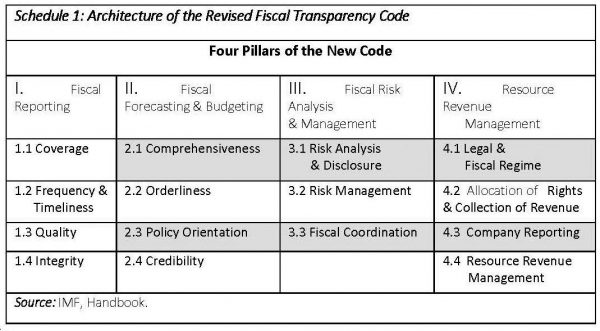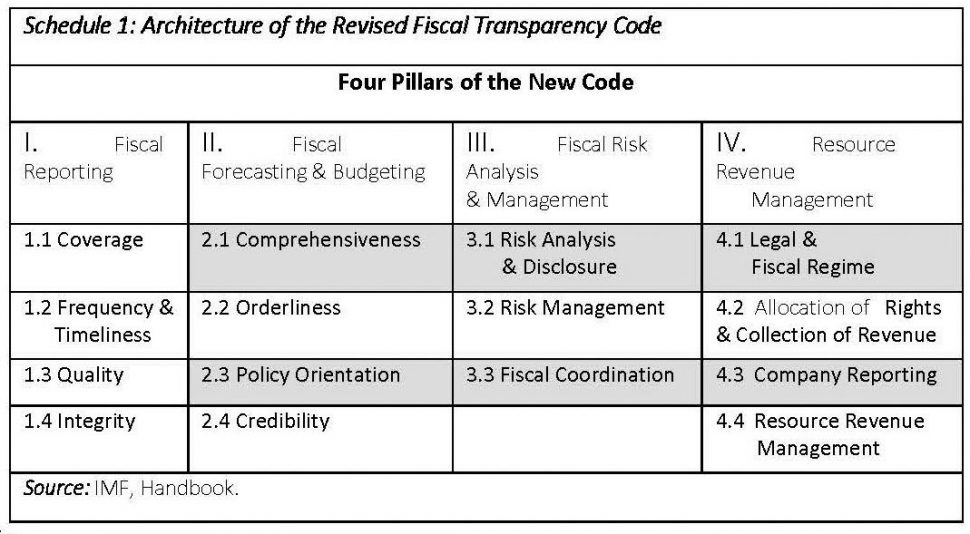 Introduction: Pillars
Introduction: Pillars
Today’s discussion concludes my evaluation of the tenth and final topic on the list of “top-10 development challenges”, which Guyana will face, as it starts to receive its petroleum revenues next year. As promised last week, I shall start with an introduction of the “four pillars” on which the Fiscal Transparency Code rests.
Pillar 1 refers to fiscal reporting. It requires “the availability of relevant, comprehensive, timely and reliable information on the government’s fiscal operations and performance”. There are 12 principles under Pillar I. These are grouped into four dimensions of fiscal reporting namely, coverage, frequency and timeliness, quality, and integrity. Pillar II refers to fiscal forecasting and budgeting. It requires a clear statement on government’s budgetary objectives, policy intentions, and projections for the evolution of its public finances. Similarly, there are 12 principles under this pillar, grouped into four dimensions of fiscal forecasts and budgets namely: comprehensiveness, orderliness, policy orientation and credibility.
Pillar III refers to fiscal risk analysis and management. It requires the coordinated management of disclosure, analysis and management of risks for public finances. This pillar is also based on 12 principles, but it is grouped into three dimensions of fiscal risk, namely, management, analysis, and disclosure of risk. Pillar IV refers to natural resource revenue management. It requires the provision of a transparent framework for the ownership, contracting, and taxation of natural resources. It too has 12 principles and is grouped under four dimensions namely, legal and fiscal regime; allocation of resource rights and revenues; company reporting, and resource revenue management. Schedule 1, summarizes this information for convenience.

Levels and Capacities
The earlier IMF Reports on the Observance of Standards and Codes, ROSCs, had emphasized the legal, institutional, and procedural arrangements for fiscal disclosure. The 2014 Code now places greater emphasis on the quality of the published fiscal information, as a more objective indicator. The 2014 Code focuses on outputs more than processes. Thus it inevitably lays great emphasis on “the quality of published information as an objective basis” for determining the level of fiscal transparency that a country attains. In so doing, it has to take into account the fact that countries operate at different levels of “institutional and other capacity”.
As a result the Code formally differentiates between practices for each of the principles indicated in the previous Section. These are: basic, good, and advanced. “Basic practice” is therefore the minimum standard IMF member countries should achieve. “Good practice” is the intermediate standard member countries should achieve. Such countries will have better than basic institutional and other capacity. “Advanced practice” is the highest standard IMF member countries will attain. As the highest international standard, they are therefore in line with current state-of-the-art policies and practices. Prior to this approach the 2007 Code had utilized a single standard for each of the practices cited in the previous Section.
This “differentiated” approach also offers a sequential path for countries to pursue when seeking to advance their level of practice. That is, from basic through intermediate to advanced. The IMF reports the Transparency Code has been “harmonized” with other standards and diagnostic tools used in the fiscal area. The IMF cites examples of this: the Open Budget Index; Tax Administration Diagnostic Assessment and the Revised Public Expenditure and Financial Accountability Framework.
As indicated, fiscal transparency evaluations (FTEs) presently constitute the IMF’s fiscal transparency diagnostic tool. These evaluations assess country practices against the Transparency Code. These offer 1) a “comprehensive assessment” of countries fiscal transparency practices compared to the Code 2) “rigorous analysis … of fiscal vulnerability” based on the Code’s indicators 3) a comprehensive review of a country’s entire public sector 4) a review of strengths and scope for reform of fiscal transparency practices and 5) “targeted recommendations to improve fiscal transparency”.
Importantly, FTEs are only carried out at the request of countries. Their aim is to aid country capacity building as well as to prioritize and deliver IMF technical assistance. Up to early 2018, as many as 30 countries worldwide have done this. These 30 countries cover many different regions and varied levels of income. The IMF constantly encourages countries to conduct FTEs; and, in 2018, it reported in this regard: “the results show there is scope for countries to improve their transparency practices”. Indeed, the results so far reveal that their efforts should be complemented with consistent efforts to expand the coverage of FTEs. This would certainly strengthen the credibility of budgetary frameworks, improve disclosure, and enhance the management of national risks; and, consequently, the global financial architecture.
The IMF analysis of already completed FTEs reveal 1) fiscal transparency levels vary across and within countries and 2) these levels are positively correlated with the level of income (IMF, 2018). Despite the above two statistical observances there is, as indicated above, scope for improvement of countries, at all income levels. Consequent to this therefore, the Transparency Code is expected to play an increasingly important role in national and global fiscal management. The recommendation for Guyana to adopt the Code is hereby strengthened as a response to the “tenth” listed development challenge”.
According to the IMF: “FTEs utilize rigorous and quantified analyses”; offer “optional sequenced action plans with defined priorities for reform”; and provide the option of modular FTEs (those that focus on one or two pillars only). The end product is an “accessible summary of the strengths, weaknesses of country practices”. FTEs are voluntary and carried out at the request of governments. And, the IMF entertains these requests as part of their “policy dialogue and capacity-building efforts with member countries”.
Conclusion
Next week, as previously indicated, I’ll begin addressing the topic of “fiscal stabilization”. Afterwards, I provide details about the promised Road Map on spending Guyana’s Government Take.





